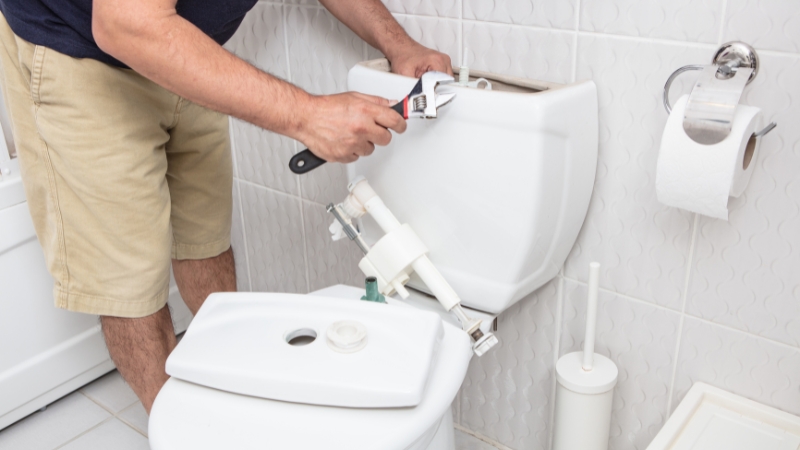If your toilet seems to have a mind of its own, constantly running and wasting water, you might be dealing with a common household nuisance: a running toilet. This issue not only causes frustration but can also lead to increased water bills if left unresolved. By understanding these signs and learning how to tackle them effectively, you can save both water and money while ensuring your bathroom remains in top-notch condition.
Table of Contents
ToggleIdentifying Signs of a Running Toilet
Constant Sound
If you hear a constant sound of running water in the toilet tank, it’s one sign that your toilet is running. This noise indicates that water is continuously flowing into the tank, even when it shouldn’t be. The sound can be subtle but persistent, like a low hum or trickle.
Another sign to watch out for is water trickling into the toilet bowl randomly. If you notice water entering the bowl at random times, especially when no one has flushed recently, your toilet may have an issue. This continuous flow of water can lead to wastage and higher bills without any visible explanation.
Increased Water Bill
An unexplained increase in your water bill could also indicate that you are dealing with a running toilet. If there are no other changes in your household’s water usage habits but you see a sudden spike in the bill amount, it might be due to a leaking or running toilet. It’s essential to pay attention to such unusual spikes as they can point towards underlying problems with your plumbing system.
Here are some key points related to identifying signs of a running toilet:
- Constant sound of running water from the tank.
- Water trickled into the bowl randomly.
- Noticeable increase in the monthly water bill without any valid reason.
Understanding Toilet Functions
Fill Valve Function
The fill valve is responsible for regulating the water level in the tank. When the toilet is flushed, the fill valve opens to allow water to refill the tank after flushing. If there’s an issue with the fill valve, it can lead to a continuously running toilet due to improper water level adjustment.
A malfunctioning fill valve may cause constant running water as it fails to shut off at the correct level. This continuous flow of water into the tank can result in wasted water and higher utility bills if left unaddressed.
Flush Valve and Flapper Operation
The flush valve plays a crucial role in releasing water from the tank into the bowl during flushing. It ensures that an adequate amount of water is dispensed for effective flushing action. On top of that, we have another essential component called a flapper, which seals off the flush valve once enough water has been released into the bowl.
If either of these components malfunctions, such as a faulty seal on the flapper, it can cause continuous leakage from your toilet’s tank into its bowl. This constant leaking results in a running toilet scenario where you hear continual refilling sounds even when no one has used it.
Common Causes of Running Toilets
Worn-out Flapper
A worn-out flapper is a common cause of a running toilet. When the flapper deteriorates, it fails to create a proper seal, allowing water to continuously leak into the bowl. This constant flow triggers the fill valve to keep refilling the tank.
Sometimes, you might notice discoloration or warping on the flapper due to age and usage. Replacing the flapper with a new one can easily resolve this issue and stop your toilet from running unnecessarily.
Misaligned Flush Valve Chain
Another cause of a running toilet is a misaligned or tangled flush valve chain. If this chain gets stuck or doesn’t allow the flapper to close fully after flushing, water will continue flowing into the bowl. This continuous stream leads to an overflowing tank and higher water bills.
To fix this problem, ensure that there’s enough slack in the chain so that it allows for smooth movement when flushing. Adjusting its length can prevent any interference with the closing mechanism of the flapper, effectively stopping your toilet from running incessantly.
Faulty Fill Valve
A faulty fill valve that doesn’t shut off properly is also among the causes behind a running toilet. When this component malfunctions, it fails to stop water from entering the tank even after reaching its designated level. As a result, water keeps flowing through without interruption.
Replacing or adjusting the fill valve can rectify this issue by ensuring that it shuts off correctly once reaching optimal water levels in the tank. By fixing this part promptly, you can prevent unnecessary wastage of water and avoid dealing with an annoyingly persistent running toilet.
Necessary Equipment for Toilet Repair
Adjustable Wrench
To fix a running toilet, you’ll need an adjustable wrench. This tool is essential for loosening and tightening connections securely. With an adjustable wrench, you can easily access different parts of the toilet system that may require adjustment or replacement. For example, if the water supply line needs to be tightened to stop leaks, the adjustable wrench will come in handy.
An adjustable wrench allows you to work on various sizes of nuts and bolts effectively. It ensures that connections are secure without damaging them due to improper tools. By having this tool ready, you can quickly address issues with your running toilet before they escalate.
Screwdriver
Another crucial item for fixing a running toilet is a screwdriver. This tool helps in removing screws that hold different components of the toilet together. Whether it’s accessing the tank or adjusting internal mechanisms like flappers or fill valves, a screwdriver is indispensable.
With a screwdriver at hand, you can easily disassemble parts of the toilet for inspection and repair. For instance, if you need to replace a faulty flapper causing water wastage in your running toilet, using a screwdriver makes it easier to access and install the new component accurately.
Replacement Parts
In addition to tools like an adjustable wrench and screwdriver, having replacement parts readily available is crucial when dealing with a running toilet issue. Components such as flappers, flush valves, and fill valves are common parts that may need replacing due to wear and tear over time.
Having these replacement parts on hand saves time when repairing your running toilet since you won’t have to make multiple trips to the hardware store while in the middle of fixing it. Being prepared with these essential items ensures that once you identify which part needs replacing based on signs like continuous water flow into the bowl or tank not filling properly; you can swiftly resolve the problem.
Steps to Fix a Running Toilet
Shut Off
To start fixing a running toilet, shut off the water supply by turning the valve clockwise. This step prevents water from flowing into the tank and bowl.
When you turn off the water supply, it stops more water from entering the tank, allowing you to work on diagnosing and repairing the issue causing your toilet to run continuously.
Drain Excess Water
Next, use a sponge or towel to drain excess water from both the tank and bowl of the toilet. Removing this excess water makes it easier to identify and address any problems within the toilet mechanism.
Draining excess water helps in preventing spills or leaks when working inside the tank or around other components of your toilet that may be malfunctioning.
Identify Issue
Once you’ve shut off the water supply and drained excess water, proceed with identifying and fixing what’s causing your toilet to run constantly. Common issues include a faulty flapper, fill valve problems, or a loose chain in some cases.
Identifying these specific issues involves inspecting various parts inside your toilet’s tank for wear and tear or misalignment. For instance, if you notice that the flush isn’t sealing properly after each use due to an old flapper, replacing it can solve this problem effectively.
- Shut off: Prevents further flow of water.
- Drain Excess Water: Eases identification of underlying problems.
- Identify Issue: Inspect parts like flappers for malfunctions.
Testing and Fixing Flapper and Flush Valve
Inspecting the Flapper
To determine if you’re dealing with a running toilet, start by checking the condition of the flapper. Look for any signs of damage or wear that could be causing water to continuously flow into the bowl. If you notice cracks, warping, or deterioration, it’s likely time to replace the flapper.
Inspecting the flapper is crucial because even a small issue can lead to significant tank water wastage over time. By addressing this component promptly, you can prevent further damage and save on your water bill.
Adjusting or Replacing Flush Valve
Another common culprit behind a running toilet is a faulty flush valve that fails to seal properly after flushing. If adjusting the flush valve doesn’t resolve the problem, consider replacing it altogether. This simple fix can make a big difference in preventing ongoing issues with your toilet’s performance.
Adjustments or replacements may seem daunting at first but are relatively straightforward once you understand how they work. Taking care of these components ensures efficient water usage and prevents unnecessary waste over time.
Testing After Adjustments
Once you’ve made adjustments or replaced either the flapper or flush valve, it’s essential to test them out before reassembling your toilet tank fully. Turn on the water supply and observe how well these components now function together in stopping water flow when not in use.
Testing after making changes allows you to catch any remaining issues early on before they escalate into more significant problems later down the line. It also gives you peace of mind knowing that your efforts have been successful in resolving your running toilet dilemma.
Inspecting Flush Valve Chain and Flapper
Check Flush Valve Chain Connection
Inspect the flush valve chain to ensure it is properly linked to both the handle lever and flapper. If there is any disconnection, reconnect it securely. A loose connection can lead to a running toilet.
Make sure the chain has some slack but is not overly loose, as this can prevent the flapper from sealing correctly. Adjusting the length of the chain might be necessary for smooth operation. You can do this by removing excess links or reattaching it at a different point.
Replace Broken Components
If you notice that either the chain or flapper is broken or damaged during inspection, replacing them may be essential for fixing your running toilet issue. A broken chain prevents proper flushing by disrupting the mechanism’s function.
Replacing a damaged flapper ensures a tight seal after each flush, preventing water from continuously flowing into the bowl when not in use. This simple fix can save significant amounts of water over time.
Replacing Flush Valve and Fill Valve
Removing Old Flush Valve
To begin fixing a running toilet, the first step is to remove the old flush valve. This can be done by unscrewing it from the tank using a wrench or pliers. Make sure to turn off the water supply before starting this process to avoid any leaks.
Installing New Flush Valve
Once the old flush valve is removed, it’s time to install the new one. Ensure that you have chosen a compatible replacement part for your toilet model. Position the new flush valve in place and securely tighten it using appropriate tools like an adjustable wrench.
Checking Fill Valve Functionality
If after replacing the flush valve, your toilet still runs continuously, check on the fill valve next. A malfunctioning fill valve could be causing water to leak into the bowl non-stop. To replace it, turn off the water supply again and disconnect both ends of the fill valve tubing before installing a new one.
Pros:
- Fixing these components can stop water wastage.
- It’s cost-effective compared to hiring a professional plumber.
Cons:
- Requires basic plumbing skills.
- Involves working with tools and potentially tight spaces in bathrooms.
When to Seek Professional Plumbing Help
Reasons to Consider Professional Help
If you’re uncertain about any repair step, it’s wise to seek professional plumbing help. Sometimes, attempting multiple fixes without success may indicate the need for expert intervention. If you lack plumbing experience or essential tools, calling a plumber is highly recommended.
When dealing with persistent issues like a running toilet despite several DIY attempts, it’s time to consider professional assistance. A continuously running toilet can lead to an increase in your water bill, making it crucial to address the problem promptly. Seeking help from a plumber ensures that the root cause of the issue is properly identified and fixed.
Benefits of Hiring a Plumber
Hiring a professional for plumbing problems offers various advantages. Plumbers have the expertise and experience needed to tackle complex issues efficiently. They possess specialized tools that are essential for diagnosing and fixing problems accurately.
Pros of Professional Plumbing Help:
- Expertise in handling intricate plumbing systems.
- Access to specialized tools for effective repairs.
- Assurance of identifying and resolving underlying issues comprehensively.
Engaging a plumber guarantees peace of mind as they can provide long-term solutions rather than temporary fixes that could recur later on. Professional plumbers can offer valuable insights into maintaining your plumbing system effectively, preventing future problems from arising.
Conclusion
You’ve now mastered the art of fixing a running toilet! By identifying the signs, understanding how your toilet works, and following the steps provided, you’re well-equipped to tackle this common household issue. Remember, a running toilet isn’t just wasting water; it’s also draining your wallet! So, take charge and fix it yourself before seeking professional help.
Don’t let a running toilet run your day – get your hands dirty, follow the steps, and show that toilet who’s boss! Your water bill will thank you, and you’ll feel like a DIY plumbing pro in no time!
Discover the Premier Solution for Running Toilets with Garcia Home Restoration!
At Garcia Home Restoration, we recognize the annoyance and waste caused by running toilets in your household. Our team, acclaimed for its proficiency in running toilet diagnosis and repair, is committed to resolving this common yet challenging issue, ensuring your home’s plumbing operates efficiently.
Our commitment at Garcia Home Restoration goes beyond mere fixes; we strive to enhance the overall functionality and conservation in your home. We have solidified a remarkable reputation in Contra Costa County for our dedication to quality, our comprehensive understanding of plumbing issues, and the trust we’ve established with numerous satisfied customers. Don’t let a running toilet escalate your water bills or disrupt your daily life. Contact us today for top-tier running toilet repair services and enjoy the comfort and assurance of a flawlessly functioning bathroom!




